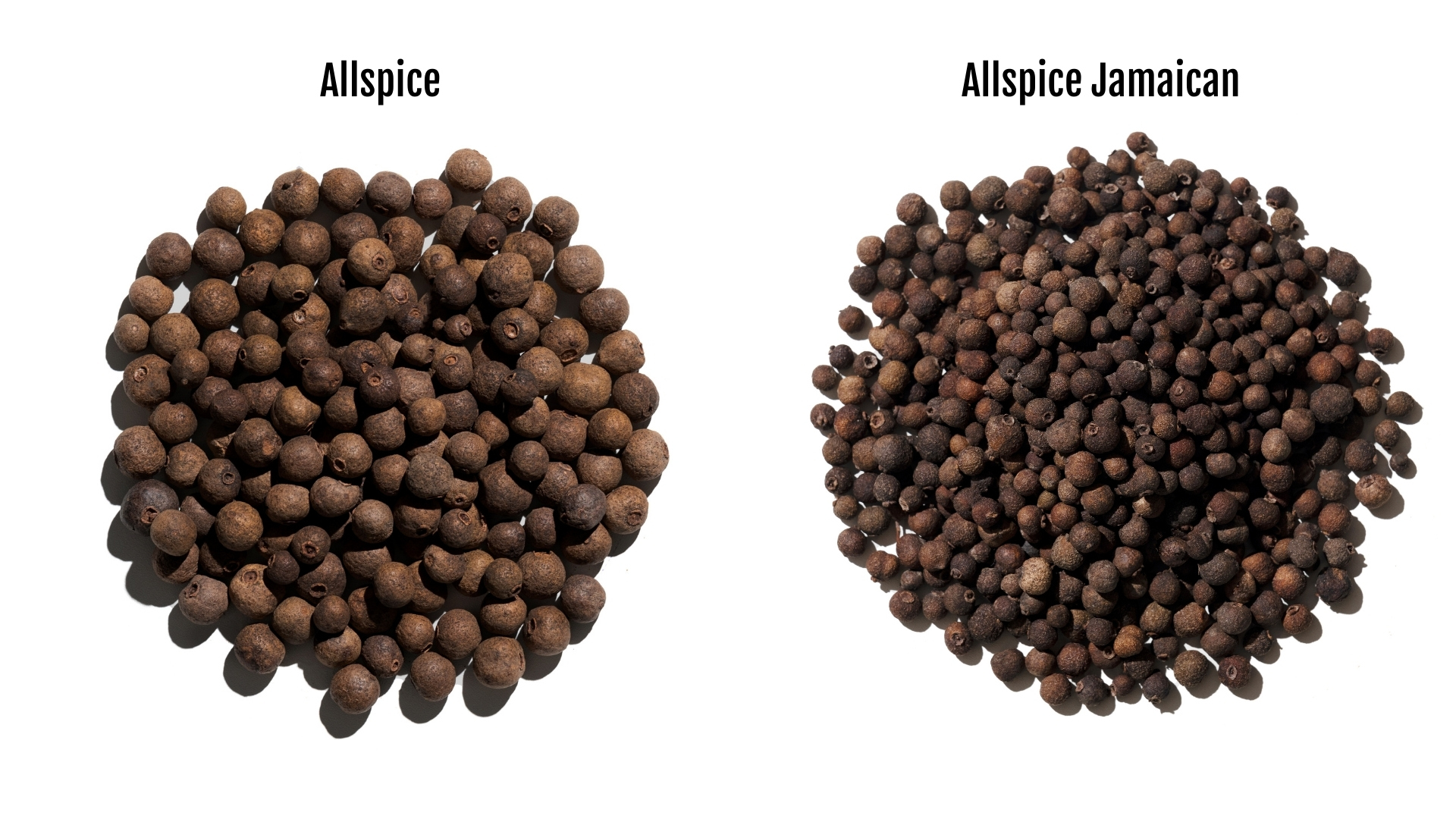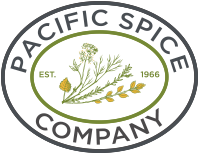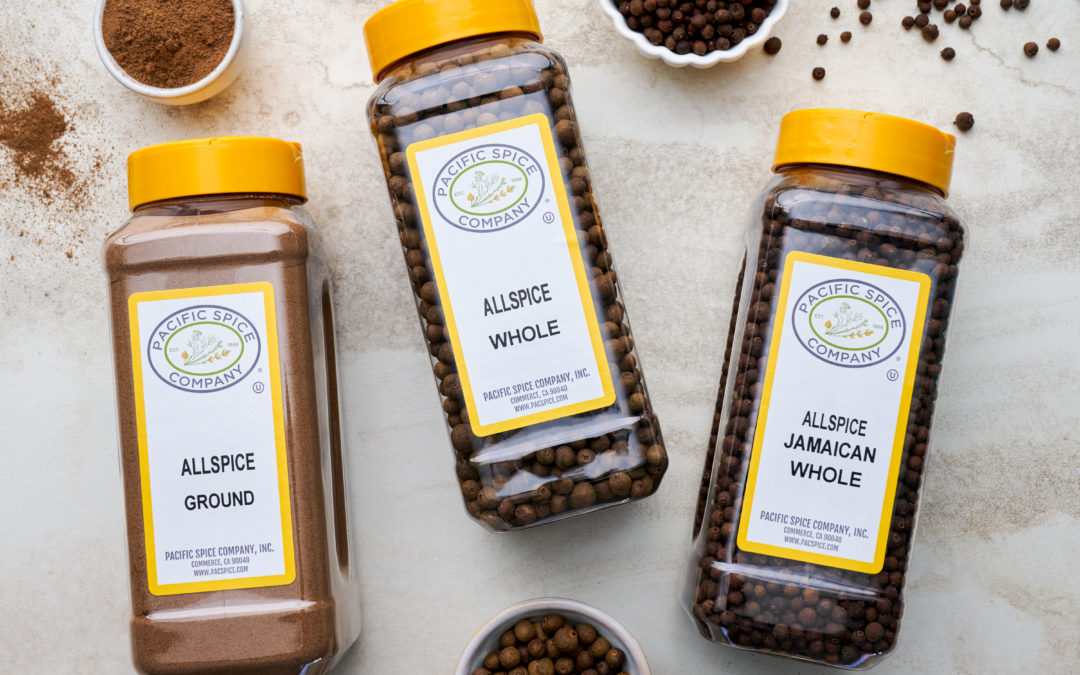Allspice is a rich and fragrant spice that flavors many sweet and savory favorites, from beef stew to pumpkin pie. It is popular in Middle Eastern cuisine and is also a key ingredient in Caribbean dishes like Jerk Chicken. Due to its bold flavor, fragrance, and unique versatility, allspice is a popular spice that is celebrated all around the world.
In this blog, we’ll discuss the history, origins, and common uses of this beloved spice.
Appearance
Allspice comes from the unripened dried berries of Pimenta officinalis Lindl., a tropical evergreen tree that is related to the clove tree. These trees grow to be about twenty five feet tall and can bear fruit for up to one hundred years. They grow exclusively in the West Indies and Central America.
There are a few main types of allspice and each type has its own distinguishing characteristics.
- Jamaican – These berries contain the highest volatile oil content (~4%), making them the most potent and flavorful.
- Mexican – Slightly larger and much darker berries. They have a low volatile oil content, which makes their flavor less potent than other varieties.
- Guatemalan – Higher volatile oil content than Mexican allspice.
To make the spice we know and love today, the berries of the Pimenta officinalis Lindl. tree are harvested while they’re still green. Picking the berries before they are ripe helps preserve their maximum flavor. After harvest, the berries are slightly fermented and sun dried for up to six days.
Flavor
Allspice contains the essential oil, eugenol, which is its primary aromatic compound. Eugenol is also the main essential oil in cloves, making these spices highly comparable.
Allspice is a naturally warming spice that gets its name from its aromatic and flavor properties which resemble a combination of cinnamon, cloves, pepper, and nutmeg (all the spices).
History
Allspice has a long, prosperous history. It is indigenous to the Caribbean and Latin America where it was used by natives to preserve meat. It was also employed as an embalming agent by the Mayans.
Brought to Europe by Christopher Columbus after his first voyage to the New World, this spice quickly spread throughout Europe. As the beloved spice grew in popularity, it was called by many names, including pimento (pepper) and sweet-scented Jamaica pepper, and English Spice. To this day, Allspice is still commonly called pimento in the spice trade.
Allspice was often sold as a replacement for round cardamom, and was used primarily for baking and for processing meat and fish. From the early 1900s until World War II, Europe alone consumed more than four times the total amount of allspice on the market today. But when supply was restricted due to WWII, the production of allspice plummeted and never recovered. Today, this spice is mainly used in Europe for pickled herring.
Today, it flavors many types of cuisine, from Middle Eastern food to Caribbean dishes, and is known all around the world as a highly aromatic, versatile spice.
Origins/Quality Sourcing
Although many have tried to grow allspice in regions around the world, the Western Hemisphere is the only place where it is grown for commercial use.
Because it only grows in one region, allspice is vulnerable to extreme weather, which can lead to failed crops. Global demand is small compared to many other spices, and shortages are very common. Another challenge is that its crop cycle is short, which leads to volatile import and spot market prices.
Today, the main producer of allspice is Jamaica, which grows the highest quality spice on the market, averaging 4% volatile oil content. Other current sources are Mexico, Guatemala, and Honduras, where it is mainly harvested from wild trees in the rain forest and averages 3% volatile oil content.
At Pacific Spice, we import our product predominantly from Mexico, Guatemala, and Jamaica.
Storing
Allspice should be kept tightly sealed under cool, dark, dry conditions; above ground and away from the wall. Excessive heat or exposure to air will dissipate its essential oils, leading to loss of flavor and aroma, while moisture will lead to mold and caking. Under proper storage conditions, the flavor strength and integrity of this product can be retained for up to one year or more.
Uses
This is a versatile spice which can be used in a variety of cooking applications, including both sweet and savory dishes. The whole spice is commonly used in pickling, while the ground spice is a prominent ingredient in various spice blends including pumpkin pie spice, apple pie spice, seafood seasoning, Jamaican Jerk seasoning, and curry. It’s also delicious on ham glazes, and in baked goods and puddings.
PSC Allspice

At Pacific Spice, we offer a number of allspice products, including:
- PSC Allspice Jamaican Whole
- PSC Allspice Whole
- PSC Allspice Ground
If you’re interested in ordering from PSC, contact us about our allspice products! When you source from us, we will help you determine the proper product for your project to maximize function, flavor, and consistency.

